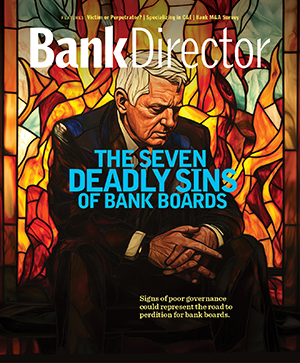
Capitalizing on Your Opportunities
The bank is doing absolutely everything right: great interest spreads, strong noninterest income, low operating expenses, superior credit quality, excellent customer service, exemplary corporate governance, a great board of directors, consistently improving earnings plus attracting, motivating, and retaining outstanding people at every level of the organization. In short the bank is a nationally recognized role model for high-performance banking-yet something is missing from the shareholders’ viewpoint.
Given the bank’s operating performance, the shareholders are not coming close to realizing the potential value of their investment. Up to this point, the bank simply has not taken full advantage of the financial management opportunities that are readily available.
High Performance Financial Management (see figure) is all about enabling growth and fully capitalizing on the operating performance of the bank. “Fully capitalizing” means maximizing the long-term value of the shareholders’ investment measured by the cumulative dividends plus the market value of the stock-pretty basic stuff, but as with many other things, it’s easier said than done.
Shareholder objectives
In an ideal world, all the shareholders would have the same objectives and goals for investing in a company. In reality, some shareholders want (often vociferously) to maximize short-term value, usually by selling the bank, while others are focused on building long-term value.
Some shareholders, for example, really need current dividend income while others are content with no dividends if the bank’s management can get a good return on retained earnings. Of interest, many banks have successfully used stock buybacks to retain only those shareholders who are on the same page, as well as having fewer of them.
Control matters
Control really does matter, the only question is how much does it matter?
Of course, making decisions is much easier if you have total control. The result of the decisions may not be better, but they will be certainly easier to make. In fact, research shows that it is easier to build ‘consensus’ when you have voting control even in a highly participatory management environment.
How do you measure control? As a friend said, “A good place to start is to count the votes.” One solution to maintain control is “to keep it small and own it all.” The other extreme is spreading ownership so broadly over thousands of shareholders that nobody has actual control, except in the unlikely instance that the shareholders band together and act cohesively toward their desires.
The role of trusted advisers
Fully maximizing shareholder value by capitalizing on your financial management opportunities requires developing and executing a carefully thought-out strategy. The long-term value of the shareholders’ investment will be dramatically affected by how well each step is executed. Having a trusted adviser or a team of advisers who fully understand all the objectives and who bring together the very best professional resources can be invaluable.
At times along the way, you will need highly specialized legal counsel, experienced and effective investment brokers, and in some instances, ready access to private equity capital. The difference in cost between using “the best of the best” advisers and using other available resources-even in terms of the hard dollars-often negotiable. Yet the difference in results can be dramatic and long lasting. Don’t underestimate your needs in this area.
The role of the board
The underlying major responsibility of the board, after taking into account a litany of legal requirements ranging from attending board meetings to complying with Sarbanes-Oxley, is to maximize shareholders’ value.
Ultimately shareholder value is determined by the level of current earnings and projected earnings per share growth. As a banker once said,” It is all about earnings, earnings, earnings.”
At the end of the day, the board’s single most important role is in maximizing shareholder value and ensuring the bank has a strong senior management team-often built by one person, an exceptional CEO. A strong management team that is ethical, talented, and highly motivated makes the board’s role relatively easy and a source of pride for its individual members.
Finally, no matter what drives the bank’s financial performance, success is 100% people. Strong senior management teams attract good people who want to play on a winning team. This “people momentum” creates the earnings performance that drives shareholder value.
The bottom line
High-performance financial management enables the bank’s shareholders to fully capitalize on senior management’s strategic vision and day-to-day commitment to excellence. The hallmark of a winning bank is having a combination of both superlative financial management and sound and efficient operating performance.

Join OUr Community
Bank Director’s annual Bank Services Membership Program combines Bank Director’s extensive online library of director training materials, conferences, our quarterly publication, and access to FinXTech Connect.
Become a Member
Our commitment to those leaders who believe a strong board makes a strong bank never wavers.

